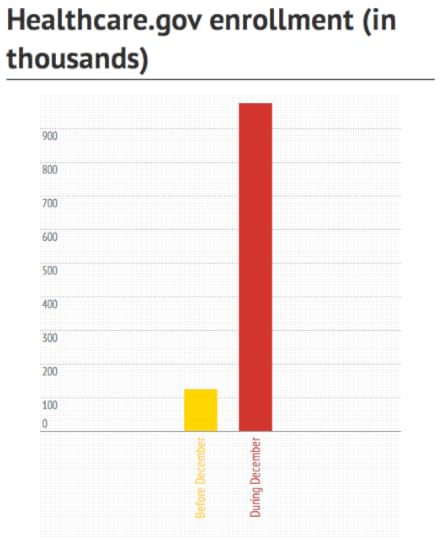The Enrollment Surge
Kliff charts it:
Most health policy experts would expect enrollment to level off, or even fall, in January and February, when shoppers aren’t facing an imminent deadline. But they do foresee a big increase at the end of March, right before open enrollment closes. These next three months will be pretty important for seeing whether the law hits the Congressional Budget Office projection of 7 million enrollees in 2014 — or, as it has in the first three months of enrollment, continues to fall short.
What Cohn is hearing:
“What’s important now is that the systems are mostly functioning so that anyone who wants to get coverage can,” says Larry Levitt, senior vice president at the Kaiser Family Foundation. “The outreach campaigns and advertising by insurers likely haven’t peaked yet, so I wouldn’t be at all surprised if enrollment in March is even bigger than December.”
MIT economist Jonathan Gruber, an architect of reforms, has a similarly nuanced take. “Given the technical problems at the start, and given that the important deadline is March 31, what matters right now is the trend in enrollment. In terms of overall enrollment, the trend looks quite good,” Gruber says. “What matters more is the mix in terms of the health of those enrolling, and we won’t have a clear answer on that until we see 2015 rates from insurers.”
Philip Klein wants more info on the health of enrollees:
CMS still hasn’t provided a demographic breakdown of those who have signed up for insurance through the exchange, which is a key metric for measuring the success of Obamacare, because the exchanges need a critical mass of young and healthy individuals to offset the cost of covering older and sicker enrollees and those with pre-existing conditions.
Avik Roy echoes:
What we need to know is: What is the breakdown of enrollees by age? What percentage have chronic conditions like Type 2 diabetes, high cholesterol, and high blood pressure? This is the kind of data that can help us compare the pool of enrollees in the exchanges to the normal U.S. population. It’s almost certain that, so far, this enrollment data is not encouraging. Because if it was encouraging, CMS would have released it.
Laszewski recommends looking at the exchanges yourself:
I suggest you do what the Democrats have been suggesting and visit HealthCare.gov. When you do, you will find that the entry page has a big icon on the left side, “See Plans Before I Apply.” Click on that and enter a sample age, state, county, and sample income. You don’t have to create an account or enter any personal information. You can take a look at any of the 36 federally run states. The site will show you all of the plans available, including the deductibles and co-pays with premiums that are net of subsidy. Unfortunately, most plans won’t let you checkout the provider network on the federal site.
Take a look. Put yourself in the shoes of lower middle-class and middle-class people who will likely have to pay 10% of their after tax income, net of the subsidy, for plans with an average Silver plan deductible of $2,567 and an average Bronze deductible of $4,343.
Will millions more buy Obamacare before March 31?



Andrew Sullivan's Blog
- Andrew Sullivan's profile
- 154 followers




